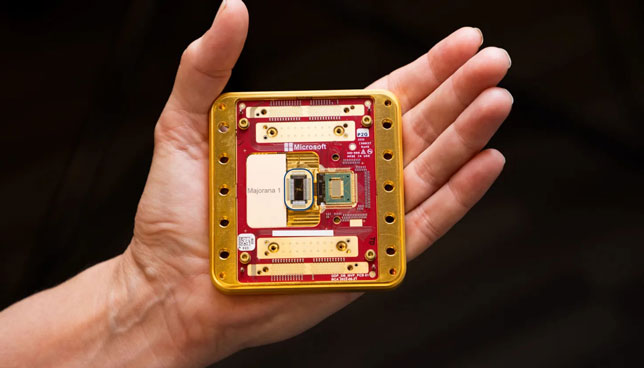
Microsoft Introduces Its First Quantum Computing Chip — Campus Technology
Microsoft Introduces Its First Quantum Computing Chip
Microsoft has unveiled Majorana 1, its first quantum computing chip, aimed at deployment in datacenters.
Fitting in the palm of a hand, Majorana 1 is the first chip designed with a Topological Core architecture, “a breakthrough type of material which can observe and control Majorana particles to produce more reliable and scalable qubits, which are the building blocks for quantum computers,” according to Microsoft.
Microsoft said this new architecture positions quantum computing closer to real-world applications, with the company projecting that quantum machines capable of solving industrial-scale problems will arrive within years rather than decades. The Majorana 1 processor will allow scaling quantum computers to one million qubits — a threshold required to tackle complex challenges.

Microsoft’s topological qubit architecture features aluminum nanowires arranged in an H shape, each containing four controllable Majorana particles to form a qubit. These qubits can be tiled across the chip, creating a scalable structure for quantum computing. The system operates within a specialized ecosystem, including control logic, extreme refrigeration, and a software stack integrating AI and classical computing. Developing the topoconductor (used instead of silicon), made from indium arsenide and superconductors, was a major challenge for Microsoft, requiring precise atomic fabrication.
Quantum computing could allow for the development of self-healing materials to repair cracks in bridges, airplane parts, phone screens and car doors. It could also solve the challenge of breaking down plastics and identifying ways to eliminate microplastics and carbon pollutants.
It could also give us a clearer picture of how enzymes work in both health care and farming. This may lead to better drug development and more efficient ways to grow crops. By improving soil health and boosting harvests, such advances have the potential to help fight global hunger and support sustainable food production, even in places with harsh climates.
“We took a step back and said ‘OK, let’s invent the transistor for the quantum age. What properties does it need to have?'” said Chetan Nayak, Microsoft technical fellow. “And that’s really how we got here — it’s the particular combination, the quality, and the important details in our new materials stack that have enabled a new kind of qubit and ultimately our entire architecture.”
Microsoft is bringing quantum computing into its Azure cloud platform, allowing users to combine it with AI, powerful computing, and traditional systems.
For more information, read the Microsoft blog.
Source link


